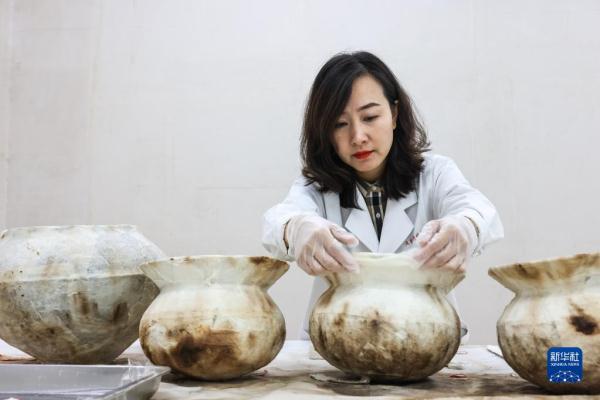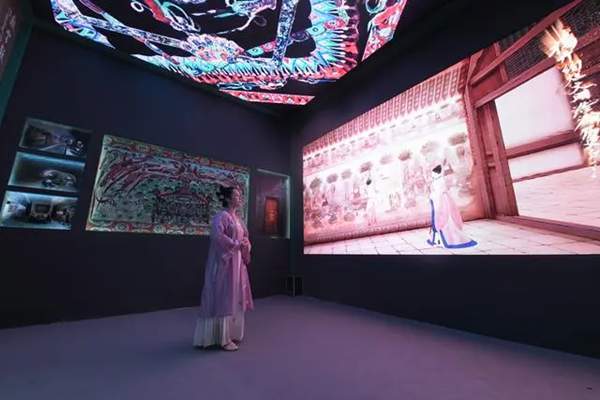Technology enhances protection of cultural relics in China
A forum on scientific and technological innovation related to cultural relics was recently held in Chengdu, the capital city of southwest China's Sichuan Province.

China's scientific research ship, Tansuo-1, carrying the crewed submersible Shenhai Yongshi (Deep Sea Warrior), is seen in Sanya, south China's Hainan Province. The ship completed the first archaeological survey of the No. 1 shipwreck, located near the northwest continental slope of the South China Sea, May 21, 2023. (Xinhua/Guo Cheng)
The forum centered on the country's major research and development (R&D) program accomplishments regarding the protection and utilization of cultural heritage. It aimed to encourage the sharing of research results, stimulate cooperation, and invigorate innovation related to cultural relics.
Since 2019, the Ministry of Science and Technology has robustly supported 36 projects within the R&D program dedicated to the protection and utilization of cultural heritage, according to an official with the National Cultural Heritage Administration.
Over 200 research teams across China from cultural heritage institutions, museums, universities, and research institutes have made achievements and breakthroughs in various areas. These include the development of a risk monitoring, prevention and control system for cultural heritage; the advancement of key technologies for protecting murals in temples and tombs; the implementation of earthquake protection for cultural relics; and the creation of technologies and equipment for deep-sea archaeology.

A "cultural relics doctor" desalinates metallic relics at the Guizhou Provincial Museum, located in southwest China's Guizhou Province, in 2022. (Xinhua/Ou Dongqu)
Experts presented their latest research findings at the forum, underscoring the importance of interdisciplinary research in key projects, including a notable project tracing the roots of Chinese civilization.
"Through the use of Bayesian statistics and kernel density estimation in dating analysis, along with comprehensively analyzing the ages of archaeological remains, we have gained new insights into the important periods of key ruins," said Chen Xingcan, director of the Institute of Archaeology under the Chinese Academy of Social Sciences.
Chen noted that significant breakthroughs had been made in dating a number of ruins including the Shimao Ruins in Shenmu, Shaanxi Province, and the Sanxingdui Ruins in Guanghan, Sichuan Province.
Technology is accelerating the preservation of cultural relics, which are vital conduits to China's rich history and culture.

A woman wearing traditional Chinese clothing visits a digital exhibition featuring Dunhuang relics at the Gansu pavilion during the 19th China (Shenzhen) International Cultural Industries Fair in Shenzhen, south China's Guangdong Province. (Xinhua/Liang Xu)
Su Bomin, director of the Dunhuang Academy, which administers the Mogao Grottoes, a 1,600-year-old UNESCO World Heritage site in northwest China's Gansu Province, shared research on key technologies for tomb mural conservation.
Su said researchers had developed various innovative tools and methods, including mobile irradiation sterilization devices, air sterilization equipment, mural protection materials with self-sterilization functions, and environmentally friendly sterilization materials. They have also developed microbial control methods such as preventive control and electron beam irradiation. Furthermore, researchers have developed smart environmental adjustment technology to protect tomb murals, while formulating effective reinforcement materials for their plaster and paint layers.
Hu Gang, an associate professor at Peking University's School of Archaeology and Museology, showcased non-destructive testing technology for evaluating the electrochemical corrosion resistance of metallic relics. He added that the technology shows promising prospects for protecting and monitoring metallic relics.
Wan Liang, a professor at the College of Intelligence and Computing at Tianjin University, spoke about intelligent analysis, digital cultural heritage data and end-to-end copyright protection.
Wan's team developed a high-quality image dataset of the Dunhuang murals, a smart computing engine, and copyright protection technologies using blockchain and digital watermarking. These developments can track online data usage and provide copyright recognition for offline data.
Wan said the team's software, hardware platforms and technologies have been implemented in the digital asset management platforms of the Dunhuang Academy and the Hunan Museum. These efforts have played a significant role in creating "Digital Dunhuang," an open platform for sharing cultural heritage.
In 2021, the General Office of China's State Council issued a plan on cultural relics protection and sci-tech innovation during the country's 14th Five-Year Plan period (2021-2025).
China will continue to strengthen basic and applied research, the application of sci-tech achievements, and promote the latest scientific research achievements regarding cultural relics. This allows advanced science and technology to inject new life into protecting and utilizing cultural relics, said an official with the National Cultural Heritage Administration.
Photos
Related Stories
- Digital technologies revive murals in Yongle Palace, China's Shanxi
- Guardians bring cultural relics closer to general public
- U.S. returns 2 illegally transported cultural relics to China
- Cultural digitalization makes progress at Sanxingdui Ruins site
- China beefs up cultural relic protection with digital technology
- Contest aims to cultivate skilled cultural relics restorers
- Cultural relics from Mawangdui Tombs of Han Dynasty exhibited in Shanghai
Copyright © 2023 People's Daily Online. All Rights Reserved.









